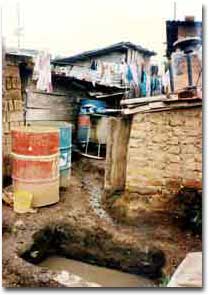|

|
 |
You can view the Issue or Tools topics by clicking on the green squares in the index below. They are categorized according to the phases in project implementation: Getting Started, Setting It Up, Carrying It Out, Capturing Experience. A more general category Miscellaneous is also included. in the index below. They are categorized according to the phases in project implementation: Getting Started, Setting It Up, Carrying It Out, Capturing Experience. A more general category Miscellaneous is also included.
|
|

|

|
|
Issues provide options, tradeoff and debates as reference for practitioners in deciding on actions.
|
Tools provide a resource for understanding how to carry out and perform actions.
|
|
|
|

|
Issues
|
|
Context:
|
 |
What is the underlying perception of the housing situation: crisis? shortage?
|
 |
How does the project fit into the broader development context?
In the context of city development initiatives, characteristics of a 'good project' are reviewed . A housing policy map shows the shifts in thinking and relation of other development programs. Notes on the more recent City Development Strategy, of the World Bank, are shown as an example of city-level planning in which upgrading is coordinated. A summary and example of the Comprehensive Development Framework of the World Bank suggests a structure at the country level. |
 |
How does the area fit into the urban structure?
Understanding the process of settlement and housing priorities within a rapidly growing city offers a reference for community upgrading strategy. |
 |
Is the area a good candidate for upgrading?
Two sets of criteria are included. One focuses more on criteria, and the other more on policies. |
 |
What are the boundaries to the project?
|
 |
What are the underlying interests of the stakeholders?
|
 |
At What Stage and Level Should Participation Occur?
|
 |
Is the level of intervention appropriate: catalyst to get things started or more intense supporting/implementing efforts?
|
|
Definition:
|
 |
What type of project is appropriate: upgrade in place, clear and redevelop, clear and relocate?
Considerations in deciding include the impact of highrises and the poor when redeveloping or relocating, the notion of ‘temporary’ upgrading in particularly problematic areas and demolition. |
 |
What will be the Scope and Objectives: Project or Program? Basic services, economic development, social, education and health improvement?
|
 |
What about Preventive measures?
Large-scale physical frameworks can channel future growth. Two examples highlight experiences |
 |
How does it consider scaling-up?
A supply-side strategy improving the delivery of how we prepare and execute programs is proposed as the key issue in scaling-up in an excerpt looking at the policy level. |
 |
How to relate user demands and services?
|
 |
How to deal with historical context?
Two excerpts are included: one deals with the basic guidelines when working in historical areas, and the other offers suggestions on how municipalities can capture profits after upgrading. |
|
Tools
|
|
|
 |
Selecting Type of Project
|
 |
Selecting Target Areas
|
 |
Identifying Stakeholders
|
 |
Positioning Issues: The Problem Tree
|
 |
Interactive Community Planning
|
 |
Participatory Rapid Appraisal (PRA)
|
 |
Tradeoffs: Bertaud Affordability Model
|
 |
Setting Priorities
|
 |
Rapid Reconnaisance/Assessment
Included are several excerpts: one is a an example of mapping with the community, another proposes simple but effective Tips for surveying in the often confusing, high density squatter areas, and the last are some cautions for understanding survey data. |


|
|
|
|

|
Issues
|
|
General:
|
 |
What are the basic issues and key tradeoffs in any project/program?
|
|
Institutional:
|
 |
What is the institutional structure for managing the project?
|
 |
Are gender issues appropriately considered?
The first article is a general overview of gender-related issues to consider when planning a project, while the second points out general concerns when including women in the process with a focus on economic development considerations. |
|
Tenure:
|
 |
The case for security of tenure.
|
 |
How will renters/landlords be considered?
|
 |
What are the policies and procedures for realignment/readjustment and legalization of individual lots?
|
|
Financing:
|
 |
What are options for financing service provision?
|
 |
How will costs be recovered?
Use fees, taxes, loan repayments, subsidies. |
 |
How will costs be collected?
|
 |
How will family house improvement loans be structured: cash/materials, collateral, repayment?
|
 |
What is the policy and procedure on defaults?
|
|
Basic Services:
|
 |
What standards will be used?
Setting Appropriate Standards explores the different agendas of the various actors involved in service provision. The Problems Involved in Standards examines the importance of distinguishing between what ought to be and what can be achieved when setting standards. |
 |
What are the alternatives in service options?
Three excerpts highlight a range of alternatives. General service delivery standards are proposed with three levels of service drawing on experience from throughout the world, followed by physical design standards used in the Calcutta Urban Development Project, India, and the very minimum ‘more appropriate’ standards used in the early Lusaka, Zambia, project. A fourth article deals with concepts for restructuring the land centered around the critical circulation layout. |
 |
Water Supply and Sanitation
|
 |
Waste Collection
Waste collection and removal are serious health issues. A table summarizes the main collection systems. Criteria and design of handcarts follows in a short summary. |
 |
Using Small-scale Service Providers
|
|
Tools
|
|
|
 |
Logical Planning Framework
A 1-page summary of why a project is carried out, what the project is expected to achieve, how it will achieve the results, which factors are crucial and a sense of what it will cost. Several variations exist. Included is an example from a project by the GTZ. |
 |
Interactive Community Planning
Included is an overview of four main types, a more detailed description of each of the main types, and a detailed, step-by-step example from South Africa of how to carry out an interactive workshop. |
 |
Interactive Dwelling Design
|
 |
Setting Standards
|
 |
Regularization of Land: Land Sharing
Included are several summaries of articles dealing with ways of carrying out land readjustment. One details an example on reblocking together with the community. A second deals with Land Sharing where the slum dwellers meet with the land owner and agree on a reorganization, and a third deals with Land Pooling. |
 |
Alternative Tenure Arrangements
|
 |
Cost-benefit Analysis
|
 |
Staffing Projects
Two articles are included which provide a guide in setting up a project office. Organizing the field office offers suggestions when hiring staff; localization of staff addresses the issue of expatriate vs local staff, which is important when considering sustainability. |
 |
Affordability and Willingness to Pay/Willing to Access
|
 |
Consensus Building
|
 |
Basic Services Alternatives
|
|
|
|
|

|
Issues
|
|
Management:
|
 |
Does it support local initiatives in construction?
General guidelines are offered at the government level and for aid agencies which consider job creation and wealth generation. Considering the informal sector as ‘hidden consumers’ suggests that they are best served by the formal private sector, with a materials and tools ‘supermarket’ as interface. |
 |
How to assure continuity of staff and community representatives?
|
 |
What is your role during contruction: direct supervision, delegated supervision, periodic review?
|
 |
What is the role of NGOs during implementation?
|

|
|
|
|
|

|
Issues
|
|
Lessons:
|
 |
How are lessons being captured? Who does it?
|
 |
How are lessons being incorporated?
|
|
Evaluations:
|
 |
What are the indicators for evaluations?
Criteria that must be met for an upgrading project to be considered successful is suggested in General Project Indicators. |
 |
Whose interests are being served? Who pays?
|
|
Monitoring:
|
 |
How will the reporting system be setup?
|
|
Impacts:
|
 |
What are the policies on displacement and spillover?
|
|
Tools
|
|
|
 |
Assessing Projects and Programs
|
 |
Indicators To See If You Got It Right
Typical indicators and alternatives in measuring impact are highlighted in Measuring Upgrading Impact. A structure for establishing indicators oriented around poverty reduction is provided in Determining Indicators. |
 |
Training cum Assessing Workshop
Aleppo Case Example
This workshop is an example of a rapid, field-based, action-oriented training workshop. |
 |
Setting Up a System for Monitoring and Evaluating Program Implementation
|
|
|
|
|

|
Issues
|
 |
History: World Bank's 25 Years of Urban Development Lending
|
 |
How Can Information Technology Be Useful for Upgrading?
eCommunities offers thoughts on linking community interests and upgrading efforts. |
|

|
|
Do you want to add an issue or tool?
Help us create and expand the Resource Framework!
Contribute an issue or tool
And thanks!
|
|
|





